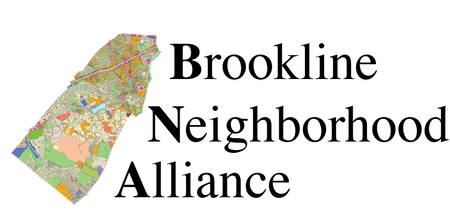Chestnut Hill Neighborhood Association
The Chestnut Hill Neighborhood Association (CHNA) was formed in 2003, a time when institutional expansion was seen as a threat to the existing balance of residential and non-residential interests in the neighborhood. As a result, its goals are to preserve the historic nature of the area, to maintain an appropriate density of residential and non-residential development, to monitor traffic safety and flow, and to minimize adverse environmental impacts from nearby development. CHNA’s boundaries are Hammond Street, Route 9, Reservoir Road, and Middlesex Road, and as such, they encompass properties in both Brookline and Newton.
The Association has traditionally sponsored a block party in September and e-mails periodic newsletters to keep neighbors informed of local and town events. Its 14-member Steering Committee meets as needed.
Within the Association’s boundaries are two architecturally distinctive neighborhoods, one of which became a local historic district (LHD) in 2005. “Chestnut Hill North”, consisting of just over 100 properties, was once farmland and woodlots belonging to the early settlers of the area – the Hammond, Druce, and Parker families. This area was developed in the late 19th and early 20th century, several decades after transportation to and from Boston was facilitated, both by the extension of Beacon Street from Kenmore Square to Newton Center and by the Woonsocket branch of the New York and New England Railroad extending from Brookline through Newton, with an H.H. Richardson-designed station in Chestnut Hill, not far from today’s MBTA stop. Beginning in the 1880s farms and country estates were sold, subdivided, and platted in a distinctive “suburban” pattern. Many who purchased the lots and built Shingle, Queen Anne, Colonial and Georgian Revival, and Arts and Crafts style homes commuted to Boston and were engaged in the trades and industries typical of the times. Among this generation of owners were wool merchants, cotton brokers, blacking manufacturers, steamship company executives, a manufacturer of printing equipment, and yes, real estate developers.
The second neighborhood within the Association’s boundaries includes many homes from the 1930s and early 1940s, a number of which enjoy the distinction of being part of a planned development sponsored by the Boston Consolidated Gas Company. Beginning in 1935, land that had previously comprised the Chestnut Hill Golf Course was subdivided and landscaped, and over fifty homes were built by the beginning of the Second World War in the Cape, Colonial, and English-Revival styles. Not surprisingly, the houses featured automatic heating, air-conditioning, ranges, refrigerators, and water heaters, all fueled by gas. Early homeowners included physicians, bankers, engineers and architects, teachers and librarians, and business executives. In addition to its architectural consistency, this neighborhood’s amenities include gravel pathways, mature red oaks, and underground electrical wiring.

